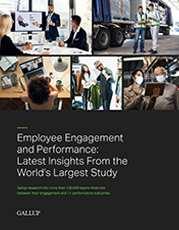Story Highlights
- All companies need to make the most of human capital
- Focus on three areas of employee development
Gallup data analysis shows that employee engagement increased in 2020 as the workforce responded to COVID-19, and most employers report productivity levels remained the same or were higher than before the pandemic. But the workforce is stressed. Parents with kids at home are struggling to get work done. Those living alone are feeling increasingly isolated. And workers everywhere are exhausted and burned out.
Meanwhile, leaders are laying plans for 2021. Creating a high-performance workplace during and after a crisis requires a new approach, one that optimizes employee engagement and productivity for a radically different environment.
The most effective interventions will support and amplify human development. Below are particularly promising development interventions -- avenues leaders should explore to engineer and sustain a high-performance workplace.
1. Performance Development Rather Than Management
Research shows that feedback confined to an annual review can do more harm than good -- that's why many companies are shifting away from infrequent reviews and toward ongoing coaching conversations. But a fundamental barrier remains: the perception that individuality -- of strengths, of needs, of obstacles -- is less important than accountability because, in the absence of accountability, employees won't contribute to the organization.
That is, some leaders assume that human nature is undependable and must be strictly controlled. To them, employees' individual strengths are a small matter compared to employees' accountability -- and, as a result, accountability and conformity come to be defined as very similar qualities. Ultimately, those qualities describe some part of employee performance, to which the organization then assigns value. Employees who don't meet that standard are left wondering if they really belong.
Creating a high-performance workplace during and after a crisis requires a new approach, one that optimizes employee engagement and productivity for a radically different environment.
High-development workplaces have a fundamentally different perspective on managing performance. They operate by responding to the needs of the workforce, empowering employees to belong to a group working collaboratively toward a mission, setting clear expectations, and describing exceptional employee performance in each role and on each team. That gives each employee a real purpose that aligns with the organization's goals, which holds everyone accountable to a strict -- and it can be extremely strict -- but individual performance metric.
These workplaces realize that human nature is creative and communal and that the employee's inherent value comes from belonging to the organization as well as meeting the standards assigned by the group. This creates a more resilient workforce, capable of overcoming difficult times. And because employees know others rely on them, their worth comes from pulling their weight to contribute to a greater whole.
2. Development Rooted in Strengths
Exceptional workplaces take performance development a step further by incorporating employees' strengths into the system -- which makes development more applicable to an organization's circumstances.
For example, onboarding new hires within the context of their strengths -- what they alone contribute and its relevance to the mission -- connects the employee to the organization quickly. That connection deepens as managers coach those strengths, even more so as new hires learn the strengths of their team members. At that point, the new hire recognizes, and feels integral to, the team's collective contributions to overall goals.
This application of unique strengths in a team dynamic reinforces employees' behavior, their feeling of belonging and improves the quality of their work. Collaboration is more effective, communication is more efficient and a shared language creates a more cohesive local culture. In a strengths-based work culture, leaders can efficiently assign work to the right teams based on team members' strengths. This creates a competitive edge that is a major leg up in today's disrupted business environment where agility is a necessity.
3. Internal Recruitment
The turmoil of 2020 highlighted the value of internal recruitment -- doing more with less depends on a highly developed, adaptable, agile staff. The process is a kind of human capital audit that will uncover gaps in skills and mindsets. Done strategically, that process pinpoints where development is most necessary.
Filling those gaps doesn't necessarily require "buying" talent. Developing it is less costly and retains institutional knowledge. At the same time, companies can -- and many should -- expand their definition of "internal" to include the local community. Whether to increase diversity, improve local relationships, or broaden the labor pool, recruiting programs aligned with the community can lead to innovative, more successful talent development practices.
Indeed, some companies, including Gallup, have programs for student workers who are recruited for their talent and advanced in the way many young adults expect from their employees. Beyond the addition of talented young hires to the organization, this practice sends the message that leadership is committed to sourcing local talent into an individualized, optimized employee experience.
Weave development and performance together.
Performance development, strengths, internal recruitment -- none of these practices are novel. They are tried and true because they improve the employee experience. They help the employee feel respected and valued. They help employees focus on what they do best every day. They help employees be part of a bigger whole as they pursue a team or an organizational goal.
The turmoil of 2020 highlighted the value of internal recruitment -- doing more with less depends on a highly developed, adaptable, agile staff.
And, perhaps most importantly, they help employees focus on what they can and can't change about the world around them. High-performing workplaces function so well because employees' span of control is exactly what it should be. As a result, those workplaces increase productivity and engagement while also sustaining them. That's a foundation that all organizations need in 2021.
Do more with less in 2021:
- Engage your employees and realize a whole host of organizational benefits.
- Learn how a strengths-based culture can tap the hidden potential of your organization.
- Inspire existing employees to go above and beyond. Watch our webinar "The New Management Style That Motivates People."




